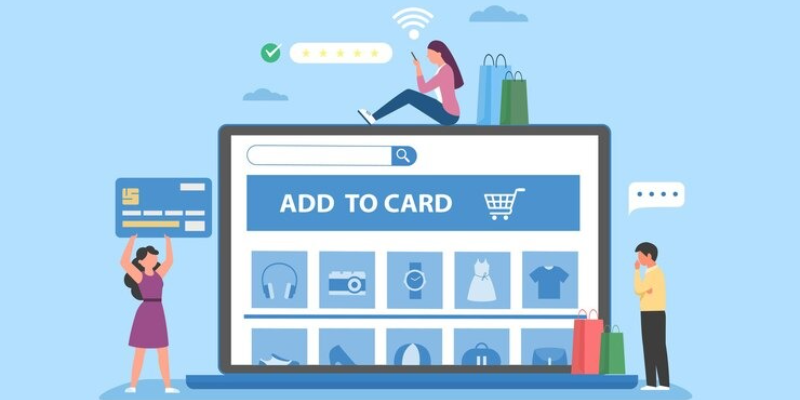

Nowadays, people do online shopping because it is easy and convenient. E-commerce websites make it easy to buy things online. Start selling your products online. This will help you reach more people and create brand awareness.
It enables businesses and people to sell and buy services or products. In other words, it provides a digital storefront wherein customers can log in to go through a virtual catalog, read product details, and place an order.
Product Information: List the product description on product pages giving detailed information about the products you sell. Give details about the material used, colour, price, availability, etc. Easy and properly arranged menus, and categories that will allow the customers to find the products quickly. Customer reviews and ratings help build up the buyer's trust.
Responsive design: A responsive website is the best since it will be able to work on various devices. It should be mobile-friendly and also easy to use on desktops and laptops.
Search Option: A search bar or field with a filtering and sorting function will easily help the customers find the products they need.
Product Suggestions: Based on the products they buy, recommend products of similar categories to encourage more sales.
Shopping Cart Access: Carts should have easy access and be easy to view products that are there in the shopping cart, and the customers should easily be able to change it if they want to change the quantity or products altogether.
Payment: Websites should offer multiple methods of payment that can include debit/ credit cards, digital wallets, etc. Guarantees that each transaction is done under utmost security and that there is no possibility of customer information getting leaked.
Account Creation: Log in so that customers can have and update their accounts to expedite the checkout process, as well as track orders. Also, maintaining details about completed orders and their current status, easy reordering or tracing of the orders.
Help Center/FAQ: A comprehensive Help section to address Frequently asked questions that customers may ask so that customers can solve their questions on their own.
Returns and Exchange: Transparent policies and procedures meant for returns, exchanges, and refunds.
Privacy Policy: Policies that outline the collection of customer data, data usage, and details of how the saved information is protected.
Data Protection: Ensures data protection both by incorporating measures to protect the user's information as well as adhering to the provided data rules and regulations.
Minimal Load Times: Quick load time is attained by the fast and efficient performance of the website.
Safe Hosting: Hosting that is scalable allows for sharp spikes in traffic, making sure the website is up at all times.
SEO Optimization: Good SEO helps in ranking your website higher on search engine pages.
Analytics Tools: Analytics tools integrated with the platform to measure user engagement, sales, and other useful statistics.
Terms and Conditions: A way of service including legal disclaimers and user obligations.
1. User Experience
It has to be easy for the user to locate the information they need quickly and without a hassle. Clear, frugal, and logical menus and structure with intuitive pathways. Make images and code very light and fast. It can be frustrating for users if websites are starting to look slow. Slow speed is bad for the user and can have adverse effects on SEO. Make the site design usable for every device like mobile, tablet, etc. Responsive design should be able to change configurations as per the different screen sizes.
2. Visual Design
Incorporate appropriate of appropriate colors, fonts, and imagery that resonate with the identity of the brand. Every page should be consistent in its design elements to ensure a unified user experience. This will include colors, fonts, and button styling. An effective use of whitespace. It will help to avoid clutter and make content readable.
3. Content Quality
Create content that is valuable and interesting. It should also meet the needs and interests of your customers. Make strong and action oriented CTAs. This might be in the form of a button to make a purchase, sign up for a newsletter, etc.
4. Accessibility
Inclusive Design: Ensure that the site is open to disabled users; elements include; adding alt texts to images, adding keyboard navigation, and taking care of the color contrast.
Standards Compliance: Adhering to the web standards as per the Web Content Accessibility Guidelines (WCAG) or any other guide provided to the relevant
5. SEO (Search Engine Optimization)
Applying keywords in a proper manner within the content, titles, and metadata to bring the websites high in the list of search engines.
Include suitable meta tags that can help provide some site description to search engines using SEO best practices. All interactive elements like form fields, buttons, and links should be in good order and make it possible for the site to function properly. Compatibility: The site must be correct and consistent in its functioning in different browsers and devices.
Use your security measures, such as HTTPS, to ensure user data is secure and generate user trust.
6. Performance and Maintenance
Periodic checks if there are any broken links or other such technical issues.
Regularly update the site with new content.
7. Analytics
Tracking: Keep track of user behavior and conversions with tools like Google Analytics that can give insights to work on.
Feedback: Collect user feedback to detect the weaknesses and perceive how users are interacting with the site.

E-commerce platforms help build websites and manage inventory and payments. Some well-known email marketing platforms are:
Manage Products: Tools to manage products and their categorization, providing prices, product descriptions, and adding images.
Shopping Cart: Help customers choose and add products for purchase into the cart before going to checkout.
Payments: Add various payment gateways to handle transactions in a secure environment. This includes processing credit/debit cards, digital wallets, and other ways of payment.
Order Management: All features for tracking and managing orders of customers, processing returns, inventory management, and updating order status.
Maintaining Records of Customer Information: Tools to store customer accounts, manage order history, and deliver personalized experiences.
Marketing and SEO: E-commerce platforms have Built-in tools to promote, optimize, email market, and other activities to improve sales and traffic.
Analytics: Businesses can make better decisions by using analytics to track sales performance, customers' behavior, and other important metrics.
Design and Customization: Theme, layout, and branding elements that conceptualize the appearance of online stores.
Security: Protection of transactions and customer data from hacking or leakage by providing SSL certificates and complying with data protection regulations.
Integration Capabilities: Be integrated with other systems or services in place, such as shipping providers, accounting software, and CRM systems.

Bud is the best E-commerce web development company in Bangalore. We provide all forms of digital marketing and advertising solutions. We provide services like web development, search engine optimization, PPC ads, Television commercials, Print ads, social media marketing, etc. With our experienced team of developers and designers, we can help you create impressive e-commerce websites that will have all the required features that you will need to sell your products online. So, let’s work together so that you can start selling online.